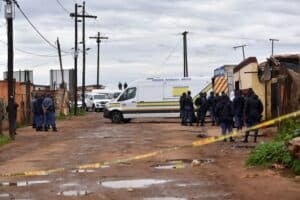The South African Heritage Agency says one of the sites is the gravesite of struggle icons Harry, Elda and Lulu Gwala.

The South African Heritage Resources Agency (SAHRA) has declared three new national heritage sites, with two named in KwaZulu-Natal.
The Sibhudu Cave, located on a farm in Sinembe, KwaZulu-Natal and the gravesite of struggle icons Harry, Elda and Lulu Gwala are the newly declared national heritage sites in the province.
The gravesite of Magrieta “Hlabi” Jantjies, who played a significant role in preserving the N|uu language of the Khoisan community, in Kameelboom Cemetry in Upington (Northern Cape), has also been declared a national heritage site.
The SAHRA said the Sibhudu Cave has contributed to the history of human evolution “through its archaeological evidence of Middle Stone Age occupation which dates to between 100,000 and 38,000 years ago”.
“Archaeological excavations in the shelter have revealed evidence of some of the earliest examples of modern human technology. It is one of only three sites in Africa with evidence of early sea-shell beads older than 70,000 years.
ALSO READ: Chief’s grave site now a heritage site in Kruger National Park
“Sibhudu Cave also has a rare collection of bone tools dating between 77,000 and 62,000 years ago. It has the world’s oldest bone arrowheads that imply that bow and arrow originated in Africa and was in use more than 30,000 years before they were used elsewhere.
“According to Geoarchaeologists, the Sibhudu Cave sediments are remarkable and amongst the best in the world for identifying behavioural moments in time. Among other finds, Sibhudu Cave has the world’s oldest evidence for bedding made from sedges, grass and leaves,” a statement by SAHRA reads.
The agency said the cave had been recognised internationally “as one of the most important sites of its kind and has been nominated as a world heritage site as part of the ‘Emergence of Modern Humans: The Pleistocene Occupation sites of South Africa’ serial nomination”.
The SAHRA said by memorialising Jantjies’s gravesite, focus was brought to “a diminishing community’s culture and sense of place”.
The agency said inscribing Jantjies’s grave with the N|uu language “was a milestone in contributing to restoring” the language.
ALSO READ: South Africa’s eight spectacular world heritage sites
“In its discussion of the N|uu, the UNESCO [United Nations Educational, Scientific and Cultural Organisation] notes, ‘a lost language is not only lost cultural heritage, it is also lost traditional knowledge, such as precious knowledge about medicinal herbs or local species or environment. Thus, with each language that disappears, humanity is impoverished in manifold ways’.”
The SAHRA added that Jantjies’s grave was both of historic and social importance to not only the Khoisan community but to the country as a whole.
“As one of the last speakers, her grave brings into the public consciousness important aspects about the South African past. The near extinction of the language speaks to the legacy of colonialism and apartheid, of land dispossession, coerced assimilation, forced labour, neglect and migration amongst others.
“The extinction of the language in a democratic dispensation as a lived community experience, further reflects the depth of this legacy. While fragments of the N|uu language are in the process of being recovered, several words from its vocabulary have been lost thus extinguishing part of the richness and diversity of our heritage tapestry.
“Thus, her grave is of cultural significance as it foregrounds a forgotten aspect of South African history.”
Compiled by Makhosandile Zulu
For more news your way, download The Citizen’s app for iOS and Android.






